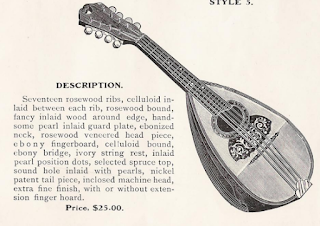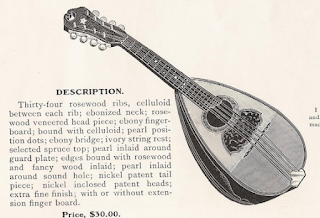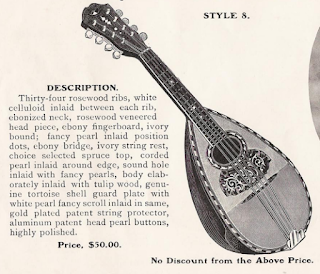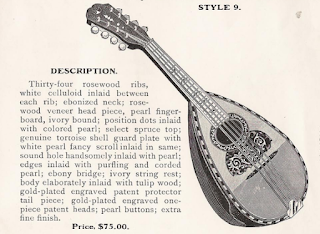Harry J. Flower & The MayFlower Music Company
Harry J. Flower was born in 1862 in Poland to Solomon and Rosa Flower and immigrated to the United States in 1868. He later married his wife Minnie who was three years his younger. They had two children, Edgar H. Flower (b. 1890, d.?) and May Flower (b.1895, d.?). The latter child would become the namesake of his company. In the 1900 census, Harry was listed as a "music dealer" [2].
The history of his company is difficult to understand due to their relatively small presence in a city dominated by musical instrument manufacturing giants. One of the big questions is whether May Flower was a distributor of instruments built by other manufacturers or if they actually build their own. Gregg Miner of HarpGuitars.net has the most in-depth research on the company, with a focus on their harp instruments, and the purpose of my article is to expand on what he has discovered.
The name appears as MayFlower, Mayflower, and May Flower in various documents which makes research confusing.
Andrew Groehsl
Early instruments include "Flower & Groehsl, manufacturers" which is a key clue. Groehsl more than likely refers to Andrew Groehsl (also written as Groeshel and Groeschel, confusingly) (b. 1860, d.?) who is more well known for founding his own instrument company that became Stromberg-Voisinet and later the Kay Musical Instrument Company.
Information about Groehsl is, unfortunately, sparse and I'm unable to discern where his company was located and where an early factory would've been.
 |
| Label from an early Mayflower Guitar (#10614) Image Credit: Instagram - Chuck Sanzone |
Larson Brothers
I've seen the Larson name come up in discussions about Mayflower instruments. I'm not well versed enough in Larson instruments to confirm or deny it but I can tell that the Groehsl branded instruments are styled similarly to Larson instruments. Its likely that Andrew Groehsl took inspiration from their designs.
Timeline
1896
Harry Flower owned a pawnshop at 86 West Madison St [13].
1898
Registration is issued for the May Flower Mandolin and ads begin appearing in local papers.
| Official Gazette of the United States Patent Office Vol 85 Image Credit
|
1900
Employee, Harry Levy, was arrested for embezzling nearly $1000 from Harry Flower. The address is listed as 86-88 West Madison St
 |
| Music Trade Review 1900 - Image Credit |
1902
The 1902 Annual Report of the Factory Inspectors of Illinois report has their location at 210 State St and lists 4 employees with 3 being "males over 16 years" and 1 "boys under 16 years" (likely his son Edgar) [3]. An entry in Proceedings of the City Council from the same year lists an issued permit for a 3 foot by 10 foot electric sign for the May Flower Music Company at their 210 State Street location [6]
This advertisement credits the May Flower mandolins to Italian luthier Antone Vallette who has them imported to the US through Harry Flower distributed by, at least, Oliver Ditson & Co
 |
| Music Trade Review 1902 - Image Credit |
1904
The May Flower Music Company adds "Joseph W. Stern and Co" as a New York dealer for their instruments. It also mentions that Oliver Ditson's company distributed May Flower mandolins before Ditson was acquired by Lyon and Healy.
 |
| Music Trade Review 1904 - Image Credit |
1905
 |
| Music Trade Review 1905 - Image Credit |
1906
The 1906 report lists their location at 272 State St with 3 employees with 1 "females over 16 years" and 2 "males over 16 years". There is new column entitled "Do they manufacture" which has a "Yes" [4].
1907
 |
| "Joliet Evening Herald" advertisement from a dealer of Mayflower instruments Image Credit |
1908
The Rudolph Wurlitzer Company acquires the "guitar and mandolin" factory of Harry Flower who was retiring from the business. This is the most important article I have found as it confirms the theory that at least some May Flower instruments were built in-house.
It states that Harry Flower owned his own factory for producing guitars and mandolins and claimed an output of "a thousand Mayflower banjos and guitars annually" as well as an undisclosed amount of mandolins.
 |
| Music Trade Review 1908 - Image Credit |
1910
The 1910 census lists Harry J. Flower as being a jeweler at a retail store.
1911
The 1911 Annual Report of the Factory Inspectors of Illinois report lists the location at 195 Wabash Ave with two employees. Both employees are males over the age of 16 years [5]. Its unclear what business they were still conducting
1913
In the 1913, Certified List of Domestic and Foreign Corporations Filed with the Recorder of Deeds, Harry J. Flower is listed as the owner of the Howard Jewelry Company at 326 S. State St with Frank B. Flower as his secretary.
1914
Harry J. Flower dies at the age of 52 [12]
1915
Harry's daughter, May Flower, marries Arthur J. Shutan and they go on to have one son, Robert Harry Shutan (b.1919, d.2008) [11][14]
Models
There only exists one catalog scan of an early Mayflower catalog which can be found here and I have uploaded a mirror here. I believe the uploader is James Garber and so all credit goes to him for the excellent find and scanning. Gregg Miner deduces that the testimonies are all dated to 1901 which would reasonably put the catalog at 1901-1902. I am only focusing on the guitar models from this catalog and not the mandolins.
I cannot find any existing instruments that match the catalog entries so its likely that this early catalog doesn't reflect the scope of instruments that they produced.
Style 201 (and I'm going to assume 202 and 203 are the other sizes). These guitars are Brazilian Rosewood with pearl inlays around the edge, a fancy wood back strip on the board, bound Ebony finger board with pearl position dots, and an Ebony bridge.
Mandolins
 |
| Harrington Special Named for mandolin player H. Scott Harrington |
 |
| Style 4 |
 |
| Style 5 |
 |
| Style 6 |
 |
| Style 7 |
 |
| Style 8 |
 |
| Style 9 |
 |
| Style 10 |
 |
| Style A |
Bracing
These bracing pictures were taken from #11186 and show a unique "H' bracing pattern kinda like what an old Gibson L-1 would have except more parallel. The braces are tucked into each other and show a high quality of workmanship. The instrument has a small spruce bridge plate) and white linen reinforcements on the top seam. The sides have a black linen reinforcement. The laminate back is very lightly braced with three low transverse braces.
I compared and contrasted with Chuck Sanzone who owns #10614 and we both found that our bracing patterns are identical and the bodies were extremely resonant when tapped.
I have owned a few 30s Kay guitars that have had a very similar bracing, likely a remnant from the Groehsl era
Existing Models
Style 102 - Concert size
Serial: #10614
Images from Reverb - Guitar Showcase
Style 202 - Concert size
Serial: #11186Image Credit: Myself
Upper Bout: 9-1/2”
Lower Bout: 13-1/2”
Body Thickness: 3-3/8” to 3-1/8”
Nut Width: 1-3/4”
Scale Length: 24-15/16”
Style ?
Serial: #?Image Credit: Worthpoint archive of an Ebay listing
Fancy pearl inlays on the headstock, fingerboard, and bridge. Attributed to the Larson brothers by seller
Style ?
Serial: #?Image Credit: Reverb - Tone Network Music
Lower Bout: 13”
Nut Width: 2”
Scale Length: 24.9”
Stauffer style headstock with pearl vine inlays and pearl bound top. Attributed to the Larson Brothers by seller
Sources
[1] http://www.harpguitars.net/history/mayflower/mayflower.htm
[2] https://www.familysearch.org/ark:/61903/3:1:S3HT-68NQ-ZHQ?i=4&cc=1325221&personaUrl=%2Fark%3A%2F61903%2F1%3A1%3AMS36-NLH
[3] https://books.google.com/books?id=fvZZAAAAYAAJ&dq=%22may+flower+music+co%22&q=may+flower#v=snippet&q=may%20flower&f=false
[4] https://books.google.com/books?id=B9FJAQAAMAAJ&pg=PA604&dq=%22may+flower+music+co%22&hl=en&newbks=1&newbks_redir=0&sa=X&ved=2ahUKEwiC8Ljs5tfsAhVNZM0KHck0DewQ6AEwA3oECAIQAg#v=onepage&q=%22may%20flower%20music%20co%22&f=false
[5] https://books.google.com/books?id=fP1ZAAAAYAAJ&pg=PA309&dq=%22may+flower+music+co%22&hl=en&newbks=1&newbks_redir=0&sa=X&ved=2ahUKEwiC8Ljs5tfsAhVNZM0KHck0DewQ6AEwAHoECAMQAg#v=onepage&q=%22may%20flower%20music%20co%22&f=false
[6] https://books.google.com/books?id=rLMVAAAAYAAJ&pg=PA1721&dq=%22may+flower+music+co%22&hl=en&newbks=1&newbks_redir=0&sa=X&ved=2ahUKEwiC8Ljs5tfsAhVNZM0KHck0DewQ6AEwBXoECAYQAg#v=onepage&q&f=false
[8] https://books.google.com/books?id=a2Q9AQAAMAAJ&pg=PA208&dq=%22harry+j+flower%22&hl=en&newbks=1&newbks_redir=0&sa=X&ved=2ahUKEwjht9Wy6tfsAhWUBs0KHTdvCnYQ6AEwBHoECAQQAg#v=onepage&q=%22harry%20j%20flower%22&f=false
[9] https://books.google.com/books?id=UZJRAQAAMAAJ&pg=RA1-PA941&dq=harry+j+flower&hl=en&newbks=1&newbks_redir=0&sa=X&ved=2ahUKEwjbp8CD6tfsAhXMQs0KHT4KB-0Q6AEwAnoECAYQAg#v=onepage&q=harry%20j%20flower&f=false
[10] https://www.familysearch.org/ark:/61903/3:1:33SQ-GRV5-SJ6?i=7&cc=1727033&personaUrl=%2Fark%3A%2F61903%2F1%3A1%3AMKCQ-13W
[11] https://books.google.com/books?id=s1ccAQAAMAAJ&pg=PA402&dq=harry+j+flower&hl=en&newbks=1&newbks_redir=0&sa=X&ved=2ahUKEwjbp8CD6tfsAhXMQs0KHT4KB-0Q6AEwBnoECAcQAg#v=onepage&q=harry%20j%20flower&f=false
[12] https://www.familysearch.org/ark:/61903/1:1:Q2MQ-LWLL
[13] https://www.newspapers.com/image/33859200/?terms=harry%2Bflower
[14] https://www.familysearch.org/ark:/61903/3:1:33SQ-GR46-GXR?i=46&cc=1810731&personaUrl=%2Fark%3A%2F61903%2F1%3A1%3AXSTW-S76



































No comments: